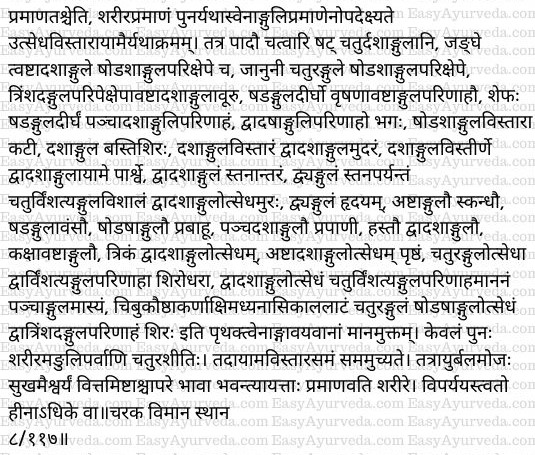Pramana Pariksha Examination Of Measurements Of Body Parts
By Dr Raghuram Y.S. MD (Ay) & Dr Manasa, B.A.M.S
Measurement of body parts is an important aspect of clinical examination of the patient. It is one among the tenfold examinations explained by Master Charaka. It is the fifth one in the list of 10 examinations to be conducted on the patient.
Pramana = quantity /measurements
Pariksha = examination
Read – 10 Factors Of Patient Examination – Dasha Vidha Atura Pareeksha

Table of Contents
Need of Pramana pareeksha
Every body part has its own measurement and dimension. Measurements of individual parts and also their relative measurements with other parts should be accurate, proportionate and balanced. These measurements and dimensions should be in sync with the overall measurement of the entire body. If these measurements are greater or lesser than what they need to be i.e. more or less than the normal values, they will be considered as disproportionate and pathological. These measurements and dimensions are different for different people.
The person in whom the body parts are proportionate both individually and relatively is said to be healthy and fit. Ayurveda was the first health science to speak about and describe the anatomical balance and proportionality of the body parts.
Read – Roga, Rogi Pareeksha: Examination Of Disease And Patient
Examination
Master Charaka tells that the patient examination shall also be done by measuring his or her body parts.
Unit of measurement – anguli pramana. This means to tell that the body parts shall be measured with one’s own finger measurement. All the measurements i.e. length, breadth, height and circumference of the body parts are measured accurately with the same units.
Anguli Pramana / Swa Anguli Pramana – is the length / measurement equal to the length of transverse measurement of one’s own middle phalanx of the middle finger. It is the unit of measurement of the length of the body parts and structures.
Read – Anguli Pramana: Linear Measurement As Per Ayurveda
The measurement of body parts as mentioned by Master Charaka are as below mentioned (all measured in anguli pramana) –
| Sl No | Part of the body | Thickness / Height | Width / circumference (cir) | Length |
| 01 | Foot | 04 | 06 | 14 |
| 02 | Legs | 18 | 16 (cir)14 (Sushruta) | |
| 03 | Knee | 04 | 16 (cir)14 (Sushruta) | |
| 04 | Thigh | 18 | 30 (cir) | |
| 05 | Testes | 08 (cir) | 06 02 (Sushruta) | |
| 06 | Penis | 05 | 06 | |
| 07 | Vagina | 12 | ||
| 08 | Waist | 1618 (Sushruta) | ||
| 09 | Base of urinary bladder | 10 | ||
| 10 | Abdomen / belly | 12 | 10 | |
| 11 | Flanks / sides of chest and belly | 10 | 12 | |
| 12 | Distance between breasts | 12 | ||
| 13 | Breast / areola | 02 | ||
| 14 | Chest / thorax | 12 | 24 | |
| 15 | Heart | 03 | ||
| 16 | Shoulders | 08 | ||
| 17 | Shoulder blades / scapular region | 06 | ||
| 18 | Brachium / arms | 16 | ||
| 19 | Antebrachium / forearms | 15 | ||
| 20 | Palms / hands | 12 | ||
| 21 | Axillae / armpit | 08 | ||
| 22 | Sacrum | 12 | ||
| 23 | Back / dorsal spine (upper back) | 18 | ||
| 24 | Neck | 04 | 22 (cir) | |
| 25 | Face | 12 | 25 (cir) | |
| 26 | Mouth / oral cavity | 05 | ||
| 27 | Chin Lips Ears Nose Forehead | 04 | ||
| 28 | In between the eyes | 04 | ||
| 29 | Head | 16 | 32 (cir) | |
| 30 | Full body | 84120 | ||
| 30 | Intestines | 3 ½ vyama (male), 3 vyama (female) |
The measurement of the entire body (height) according to Master Charaka is 84 anguli.
Read – Anjali Pramana: Volume Measurement As Per Ayurveda
Sanskrit verses

Types of body measurements
Depending on the above-mentioned explanation of Master Charaka, the measurements of the body can be of 3 kinds. They are –
1. Sama Sharira / Ayama-vistara samam – Proportional Body Frame / measurements
The body is said to be proportional or of having accurate measurement if the length and breadth of the body is of same measurements.
How to calculate –
a. The distance from crown of the head to the foot is measured and noted down. This will be 84 angula in measurement.
b. The person is asked to extend his arms such that they are horizontal to the length of the body and parallel to the floor. Now the distance between the tips of middle fingers are calculated and noted down. This should also be 84 angula in measurement.
‘Distance a’ should be equal to ‘distance b’ i.e. the distance between head and foot should be equal to the distance between the tips of the middle fingers when arms are extended. Now the length and breadth of the body are said to be equal and the body is said to be proportional. This proportionality is an indicator of perfect health of the individual.
When the body measurements i.e. length and breadth are equal and proportional the person will be bestowed with longevity, and best of strength, essence of tissues (ojas), happiness / pleasure, wealth, goodness and auspiciousness. Everything they think will happen i.e. the person can achieve anything in life just by thinking of it and with determined approach. These people are immensely blessed with fortune.
Read – Signs Of Person Having Enriched Bones (Asthi Sara Purusha Lakshanas)
2. Madhyama Sharira – Excessive body frame / measurements
The body is said to be having medium measurements if the length and breadth of the body are in excess of what is desired to be considered as proportional i.e. disproportionate body frame wherein length and breadth are more than the normal limits.
Either the length will be more than 84 angula or the breadth will be more than 84 angula or both these dimensions will be more than the mentioned value.
When the body measurements i.e. length and breadth are unequal and disproportional i.e. more than normal dimensions – the person will be bestowed with moderate life span and moderate amounts of features like strength etc as mentioned in sama sharira type.
Read – Bala Samprapti: Understanding pathogenesis Based On Causes And Symptoms
3. Hina Sharira – Lesser body frame / measurements
The length and breadth of the body are less than what is desired to be considered as proportional i.e. disproportionate body frame wherein length and breadth are less than the normal limits.
Either the length will be lesser than 84 angula or the breadth will be lesser than 84 angula or both these dimensions will be lesser than the mentioned value.
Here the person will be bestowed with less life span and less amounts of features like strength etc as mentioned in sama sharira type.
According to Sushrutha
The height of Sarva Shareera (No 29) is given as 120 anguli. Dalhana, commentator of Sushruta Samhita tells that the height of the body with both upper limbs raised is 120 angulis.
Vyama (No 30) – Distance between right and left fingertips when both the arms are completely abducted. Sushruta has mentioned the dimension of Stree vaksha (chest of female) as 18 angulas
Read – Acharya Sushruta: Work, Samhita, Legacy, Amazing Facts
Significance of Anguli Pramana
Anguli pramana gives us an accurate measurement of the body parts. When they are in normal proportions, they indicate good health. Anything less or more than the mentioned norms would suggest abnormality and pathology. It indicates that there is a proportional imbalance in body dimensions. This would indicate that the person whose anguli pramana is being measured is not at the best of his or her health.
Click to Consult Dr Raghuram Y.S. MD (Ayu)









